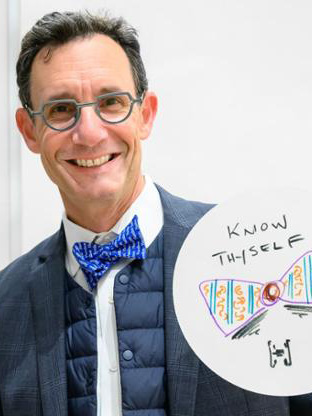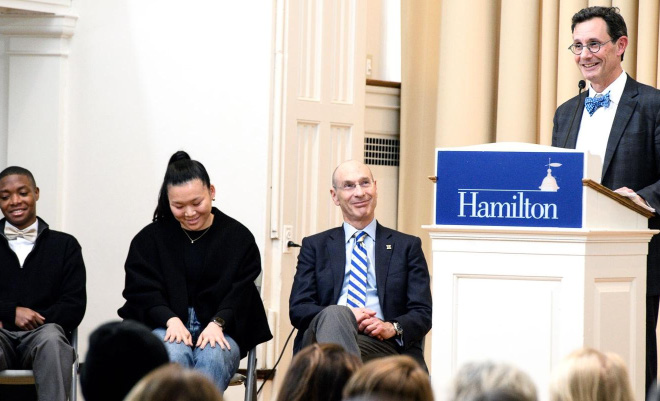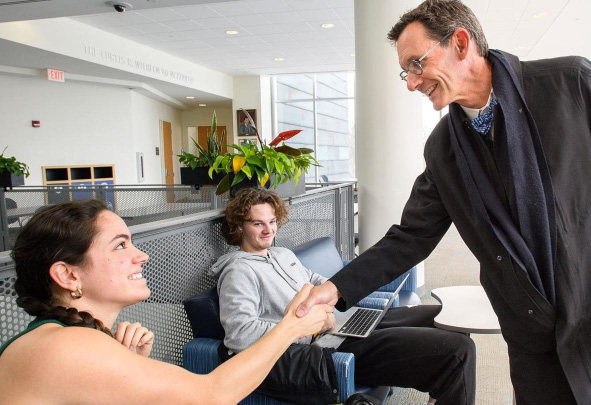
On Thursday Feb. 29 in the Chapel, President-elect Steven Tepper addressed opening remarks to the Hamilton community, which included students, faculty and administration. Prior to taking the stand, President-elect Tepper was introduced by student representatives for the presidential search committee Sophie Thompson ’24 and Quentin Messer ’26, President David Wippman and trustees Bob Delaney ’79 and Linda Johnson ’80.
Messer and Thompson acknowledged Tepper’s “vibrant passion for the Hamilton community” alongside his willingness to “represent all interests of the student body.” Wippman remarked that although he would miss “the beauty of Hamilton’s campus, rhythm of academic life and its community” upon his departure at the end of the Spring 2024 semester, he is proud to know that “Hamilton has found the perfect leader to usher a new generation.”
Johnson followed by thanking Wippman for his work at Hamilton, which included “launching Common Ground, investing in new technologies and maintaining a steady hand during the pandemic.” As co-chair for the Search Committee, Johnson described the ideal presidential candidate for the college’s future: “Hamilton seeks a president with a deep and scholarly commitment to the liberal arts, fostering curiosity and courage. They should engage with all cohorts of the community and hold regular dialogue with alumni across many generations.”
Finally, Delaney noted some personal attributes that made Tepper stand out beyond doubt. “When you are talking to [Tepper], you feel like you are the only one in the room. He has shown a keen interest in our unique experiences. We have found someone whose beliefs in the liberal arts match with the values at Hamilton.”
Tepper began his address by highlighting Hamilton’s “legacy, experience, culture, future,” and the honor it is to work as its next president. He praised Wippman as a “dedicated and exceptional leader that has prepared the college for its future.” Throughout the day, Tepper got the chance to “visit classrooms and see facilities” throughout the day, embracing the “amazing energy of the campus community.” This environment reminded Tepper of his son’s willingness to interact with others on the playground, which represents “important lessons about joining a community and learning from everybody.” Tepper then joked about the reasons for his departure from Arizona: “I accepted this position to get to work alongside you, but to be honest, I could not take the relentlessly good Arizona weather, there was too much Vitamin D.”
Following his initial remarks, Tepper dove into his personal past and deep-rooted connection to creativity. “You could call me a Smithsonian Baby since I used to go to every museum in D.C. I was always drawn to the power of the picture, the way to look at print, texture, power and color that creates contrast and depth. Creativity is the engine that lies behind every innovation in science and culture.” At 17, Tepper’s experiences as a young artist casted self-doubt on his vision of creativity. “While drawing a still life, a young man next to me painted his self portrait as a reflection in the vase, which casted an unbelievable seed of doubt that I was not a creative person. My conclusions at that age drew on historical myths, such as the lone genius that sees the world like none other, the eccentric person that is weird, or the rational individual thinking they are not creative. That is not true. Since then, I’ve spent the rest of my life placing creativity at the center of democracy, community building, and work.”

“President Tepper struck me as a very affable man who cares about social interactions on our campus. I’m counting on him to ameliorate our student life and much more going forward,” Quinn Liu ’26 said.
Tepper then continued by pointing out the creativity that lies within Hamilton. “[Hamilton’s] commitment to an open curriculum, original research and discovery, openness to asking the ‘what if’ questions, work with continuously evolving technologies, teaching styles and ideals make it one of the best liberal arts colleges in the nation.” Tepper expressed admiration for the “power and passion of a liberal arts education.” 2,000 years ago, liberal arts thinking was “forged as a way to learn beyond tablets and engage by being fully exploratory. Believing there is something new to learn and being prepared to answer the difficult questions,” Tepper stated.
Thinking into the future, Teper asked the audience to imagine the coming years of their campus through the lens of various collective considerations. “What if we make Hamilton a democracy makerspace, approaching the most contentious issues of our time from a place of inquiry and learning?” “What if we develop an approach to artificial intelligence that is grounded in a liberal arts education, as a means for slow, deep and sticky learning?” “What if we are known for failure, as the seed for learning and growing. A learner that can adapt, embrace the feedback and be so excited that they reimagine their ideas and design them for failure?” Tepper pondered. While acknowledging that perspective for the future, Tepper emphasized the collective importance of communication as a vehicle for change on Hamilton’s campus. “I have ideas, you have ideas, but ideas that exist in our heads are only ideas. Visions are born from the work we all do together, over the next months and years,” Tepper stated.
In his concluding statements, Tepper outlined his vision for the future. “What if we blaze new paths that become a factory for sustainability and imagination? What if we prepare for a world where Hamilton graduates can possess exceptional communication skills, entering the workforce with the confidence to propose and argue? I believe in critique without judgment and failure without fear. We will tell our story louder and more brightly. There is an unbelievable story to tell,” Tepper commented. As Hamilton’s 21st President, Tepper is “ready to learn, take Hamilton’s energy in and return it with even more enthusiasm and energy for the future.”

















